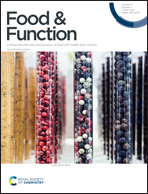Yeast β-1,3-glucan production by an outer membrane β-1,6-glucanase: process optimization, structural characterization and immunomodulatory activity†
Abstract
The β-glucan from Saccharomyces cerevisiae is a potent adjuvant that exhibits a broad spectrum of biological activities and health benefits, and different processes have been established to prepare active β-glucan from yeast. However, studies concerning the effect of β-1,6-glucanase enzymolysis on the structure and immunomodulatory activity of yeast β-1,3-glucan are scarce. In this study, we aim to develop a novel enzymatic process for the preparation of immunologically active β-glucan (BYG) from baker's yeast using a β-1,6-glucanase GluM. The β-1,6-glucan in fungal cell wall was specifically hydrolyzed by GluM, and resulted in cell wall decomposition and β-glucan release. Batch production of BYG was realized with 17.8% yield, 85.3% purity and 75.4% recovery rate. Structural characterization indicated that BYG exhibits rod-like structures with natural triplex and nanoparticle-like substructures compared with the commercial Glucan 300. BYG ameliorated inflammation in a DSS-induced mouse model of colitis through inhibiting oxidative stress (NO, MDA and MPO), inflammatory mediators (NLRP3, ASC, caspase-1, iNOS and COX-2), and pro-inflammatory cytokines (IL-1β, IL-6, TNF-α, IFN-γ), increasing the expression levels of tight junction proteins (ZO-1, occludin and claudin-1) and modulating the production of gut microbiota-synthesized SCFAs compared to the control. Our results showed that yeast β-1,3-glucan prepared with β-1,6-glucanase exhibits structural integrity that is responsible for its favorable immunomodulatory activity.



 Please wait while we load your content...
Please wait while we load your content...